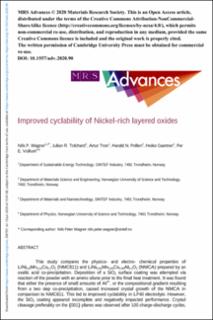| dc.contributor.author | Wagner, Nils Peter | |
| dc.contributor.author | Tolchard, Julian R | |
| dc.contributor.author | Tron, Artur | |
| dc.contributor.author | Pollen, Harald Norrud | |
| dc.contributor.author | Gaertner, Heiko | |
| dc.contributor.author | Vullum, Per Erik | |
| dc.date.accessioned | 2020-09-14T13:59:16Z | |
| dc.date.available | 2020-09-14T13:59:16Z | |
| dc.date.created | 2020-02-07T10:02:06Z | |
| dc.date.issued | 2020 | |
| dc.identifier.citation | MRS Advances. 2020, . | en_US |
| dc.identifier.issn | 2059-8521 | |
| dc.identifier.uri | https://hdl.handle.net/11250/2677759 | |
| dc.description.abstract | This study compares the physico- and electro- chemical properties of LiNi0.8Mn0.10Co0.1O2 (NMC811) and LiNi0.83Mn0.06Co0.09Al0.1O2 (NMCA) prepared by an oxalic acid co-precipitation. Deposition of a SiO2 surface coating was attempted via reaction of the powder with an amino silane prior to the final heat treatment. It was found that either the presence of small amounts of Al3+, or the compositional gradient resulting from a two step co-precipitation, caused increased crystal growth of the NMCA in comparison to NMC811. This led to improved cyclability in LP40 electrolyte. However, the SiO2 coating appeared incomplete and negatively impacted performance. Crystal cleavage preferably on the {001} planes was observed after 100 charge-discharge cycles, Downloaded from https://www.cambridge.org/core. SINTEF, on 13 Jun 2020 at 10:36:09, subject to the Cambridge Core terms of use, available at https://www.cambridge.org/core/terms. https://doi.org/10.1557/adv.2020.90 with consequent cathode electrolyte interphase formation in the crystal cracks. This is believed to cause capacity decay via lithium loss, and increased charge transfer resistance. An FEC based electrolyte improved the cyclability in all cases and even under extreme conditions (45°C and upper cycling potential of 4.5 V) NMCA showed a capacity retention of 85% after 100 cycles | en_US |
| dc.language.iso | eng | en_US |
| dc.publisher | Cambridge University Press | en_US |
| dc.rights | Navngivelse-Ikkekommersiell-DelPåSammeVilkår 4.0 Internasjonal | * |
| dc.rights.uri | http://creativecommons.org/licenses/by-nc-sa/4.0/deed.no | * |
| dc.title | Improved cyclability of Nickel-rich layered oxides | en_US |
| dc.type | Peer reviewed | en_US |
| dc.type | Journal article | en_US |
| dc.description.version | publishedVersion | en_US |
| dc.source.pagenumber | 8 | en_US |
| dc.source.journal | MRS Advances | en_US |
| dc.identifier.doi | 10.1557/adv.2020.90 | |
| dc.identifier.cristin | 1791894 | |
| dc.relation.project | Norges forskningsråd: 280910 | en_US |
| dc.description.localcode | MRS Advances © 2020 Materials Research Society. This is an Open Access article, distributed under the terms of the Creative Commons Attribution-NonCommercialShareAlike licence (http://creativecommons.org/licenses/by-ncsa/4.0/), which permits non-commercial re-use, distribution, and reproduction in any medium, provided the same Creative Commons licence is included and the original work is properly cited. The written permission of Cambridge University Press must be obtained for commercial re-use | en_US |
| cristin.ispublished | true | |
| cristin.fulltext | original | |
| cristin.qualitycode | 1 | |

